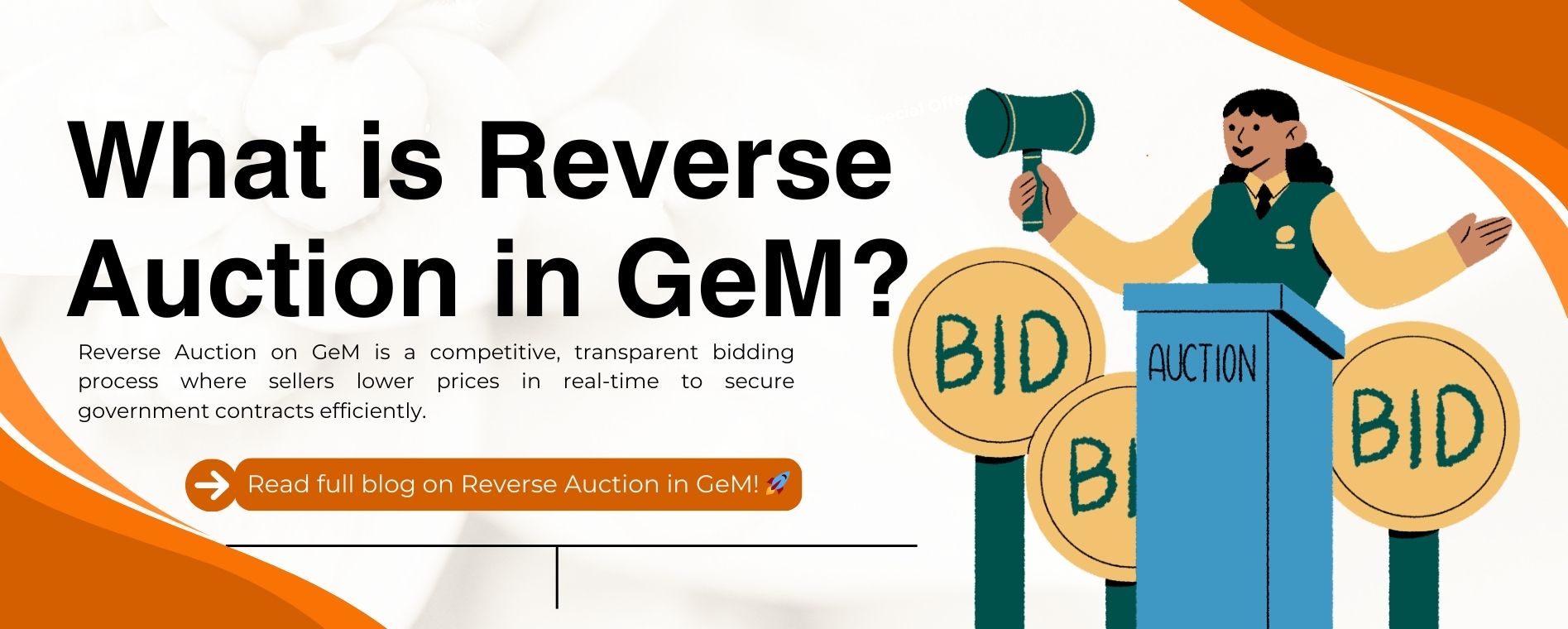
What is Reverse Auction in Gem?
The Government e-Marketplace (GeM) is an innovative online platform that facilitates procurement of goods and services by government departments, organizations, and businesses. One of the most beneficial features of GeM is the Reverse Auction, which allows buyers to procure products and services at the most competitive prices. Everyone is willing to work with the government to get the best deal because prices keep going down. This process fosters transparency, efficiency, and cost reduction while ensuring quality and compliance. This blog provides a concise overview of the Reverse Auction process on the Government e-Marketplace (GeM), highlighting its key points and benefits.

Understanding the GeM Reverse Auction Process
In a reverse auction, vendors bid against one another by lowering their pricing for the same good or service until the lowest bid is made. The contract is awarded to the lowest bidder (L1). Reverse auctions reduce costs, which greatly Benefits of Reverse Auction in GeM or government procurement, in contrast to typical auctions when buyers submit greater bids.
Step-by-Step Reverse Auction Process in GeM
1. Initiation of Reverse Auction
-
A two-way sale starts with someone wanting to buy something. Usually, the government.
- Users and how they should use it are already limited by rules.
- It is often used for high-value purchases and bulk procurement.
2. GeM Seller Participation
The reverse auction is only open to GeM seller registration vendors that fulfil the requirements.
- Non-eligible people are not allowed to join GeM.
- When more people bid on something, it costs less to buy it.
3. Price Determination
-
Sellers continuously submit lower bids within a specified timeframe.
-
Buyers and sellers decide how much to charge based on what other sellers are offering.
-
The auction concludes when the lowest bid is achieved within the stipulated time.
4. GeM E-Bidding Stopped, and the Winner Selection
-
The lowest bidder (L1) is proclaimed the winner after the auction concludes after a predetermined amount of time.
- When our employees find the best deal, they make sure it's legal and safe to use.
- If everything looks good, the L1 buyer will get the deal approved.
GeM Reverse Auction Guidelines
When It Happens – Reverse Auction (RA) is conducted after the technical evaluation of bids, allowing qualified sellers to compete on price.
Bidding Process – Sellers submit lower bids than the current lowest bid, with a minimum decrement value set for each bid.
Duration & Extensions – The auction has a fixed duration, but if a bid is placed in the last few minutes, the time extends automatically to ensure fair competition.
Starting Price – The RA begins from the lowest price quoted in the initial bid process.
Compliance – Sellers must follow GeM’s or Government e-Marketplace (GeM) Auction guidelines to ensure a fair and transparent process.
Key Benefits of GeM Reverse Auction
1. A huge drop in costs
-
Many businesses charge various amounts for the same thing, which helps the government save a lot of money.
-
Takes away dealers that aren't needed, which lowers the price of buying.
2. Transparency and Fair Competition
-
Since the entire procedure is carried out online, complete responsibility and visibility are guaranteed.
-
To avoid misconduct, every bid and transaction is digitally recorded.
3. Efficiency & Speed
-
Anytime between days and weeks, you can make this kind of sell. It takes minutes or hours.
-
It's easier for everyone when checks are done automatically.
4. It increases the chance of a tough fight
-
Buyers can be anyone who wants to sell.
-
Others can sell to you, so they need to offer better deals.
5. Opportunities for small businesses
-
Larger buyers can compete with Micro, Small, and Medium-Sized Businesses (MSMEs) in reverse bids.
-
The government will work with businesses of all kinds. Things can be bought now by anyone.
_______________________________________________________________
When to Use Reverse Auction in GeM?
Reverse auctions are particularly effective in the following scenarios:
-
Bulk purchases where large quantities are required at competitive prices.
-
Standardized goods or services where quality and specifications are well-defined.
-
High-value procurements that require cost reduction and market efficiency.
-
Multiple supplier’s available, ensuring active participation and competitive bidding.
Key Considerations for Sellers in Reverse Auction
1. Some things need new plans and ideas, so that might not be the best way to buy them.
-
Consider these things if you want to buy something at a public sale
-
Before you bid, do some research on what the buyer's agent wants.
-
Whatever you sell to GeM should really help them.
2. Give what other people say some though
-
Sellers must closely monitor competitor bids and adjust pricing strategies accordingly.
-
Create a strategy for how you will change your bids to win and stay in the GeM.
3. Ask for too little money.
-
Even if your price is the lowest, you can still make money.
-
Do some research on the rules, taxes, and how to get there before you bid?
Follow GeM's instructions.
-
The rules must be followed before you can bid.
-
Sending the right papers and seals is necessary for them to accept you.
5. Figure out how you'll ship and pay.
-
Your price should be fair, and the work should be finished quickly.
-
Make sure you have enough stock to follow the rules when you first open your business.
What could go wrong with sale items that can be returned?
The good and bad things about backward bids are as follows:
-
There are too many of them for prices to stay high, and businesses will close down.
-
Quality-related carelessness: Some sellers may cut corners on quality to stay competitive.
-
Using tools that let them bid might be hard for a small business right now.
-
Planning how to set prices can go wrong if bids are changed at the last minute.
-
Price things correctly if you want to sell them. Good things should be given and rules should be followed.
-
Buyers won't pay the right amount or too little.
-
Keep looking for real deals. Don't just bid once and then wait; take part in the entirety of the auction.
-
This information can help you offer things for sale in How to win tenders on GeM.
How GeM Reverse Auction Competes with Other Platforms
GeM is one of the leading government procurement platforms, competing with IndiaMART, mjunction, and OfBusiness, which also facilitate B2B transactions and procurement. However, GeM’s Reverse Auction process is more structured and transparent compared to:
- IndiaMART, which primarily acts as a listing platform for businesses but lacks a structured reverse auction mechanism.
- Mjunction, which facilitates large-scale e-auctions, primarily for steel and coal industries, but has a limited focus on government procurement.
- Of Business, which provides financial solutions along with procurement but does not emphasize competitive bidding like GeM.
Compared to these platforms, Bidhelp offers specialized guidance and real-time bidding support, ensuring sellers can navigate GeM Reverse Auctions efficiently and maximize their chances of winning contracts.
Quick Q&A on GeM Reverse Auction
Q1: What is a GeM Reverse Auction?
A Reverse Auction on GeM is a process where sellers compete by lowering their prices, and the lowest bidder (L1) wins the contract.
Q2: Who can participate in a GeM Reverse Auction?
only registered and eligible sellers on GeM can participate in reverse auctions.
Q3: How does a Reverse Auction benefit buyers?
It helps reduce costs, increase competition, and ensure transparent procurement.
Q4: How long does a Reverse Auction last?
it typically lasts a few hours or days, depending on the buyer’s requirements.
Q5: What happens after a seller wins the auction?
The L1 bidder in GeM is verified, and if compliant, they receive the contract award.
Q6: How can sellers increase their chances of winning?
By offering competitive pricing, ensuring quality, and understanding market trends.
NOTE:-
If you're unsure how to respond to a tender, need help with documentation, or want to increase your chances of winning bids — reach out to Bidhelp, India’s trusted partner for GeM listing, bid support, and tender consultation.
______________________________________________________________
Conclusion
GeM’s Reverse Auction anyone can get things for the government through GeM Bidding Process backward sales. GeM’s Reverse Auction is a powerful tool that ensures competitive pricing, transparency, and better value for government procurement. It empowers buyers to get the lowest possible rates while giving sellers a fair chance to win based on pricing strategy. For businesses, mastering reverse auction can unlock consistent orders and long-term growth in the government marketplace.
Comments
No Comments To Display
Leave a comment
TENDER BY STATES View All
Andaman & Nicobar Tenders |Andhra Pradesh Tenders |Arunachal Pradesh Tenders |Assam Tenders |Bihar Tenders |Chandigarh Tenders |Chhattisgarh Tenders |Dadra & Nagar Haveli Tenders |Daman & Diu Tenders |Delhi Tenders |Goa Tenders |Gujarat Tenders |Haryana Tenders |Himachal Pradesh Tenders |Jammu & Kashmir Tenders |Jharkhand Tenders |Karnataka Tenders |Kerala Tenders |Ladakh Tenders |Lakshadweep Tenders |Madhya Pradesh Tenders |Maharashtra Tenders |Manipur Tenders |Meghalaya Tenders |Mizoram Tenders |Nagaland Tenders |Odisha Tenders |Pondicherry Tenders |Punjab Tenders |Rajasthan Tenders |Sikkim Tenders |Tamil Nadu Tenders |Telangana Tenders |Tripura Tenders |Uttarakhand Tenders |Uttar Pradesh Tenders |West Bengal Tenders |


 2025-05-09 18:34:03
2025-05-09 18:34:03

